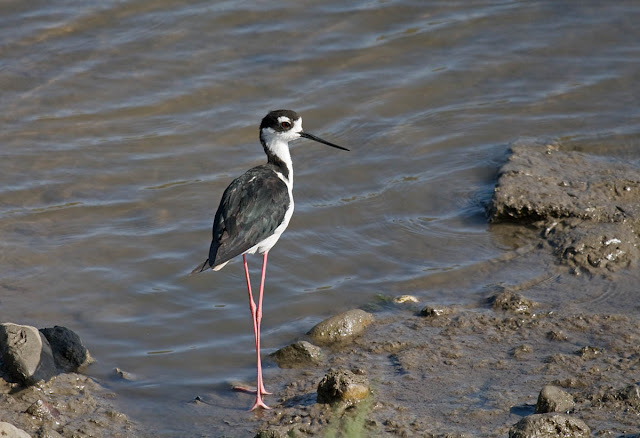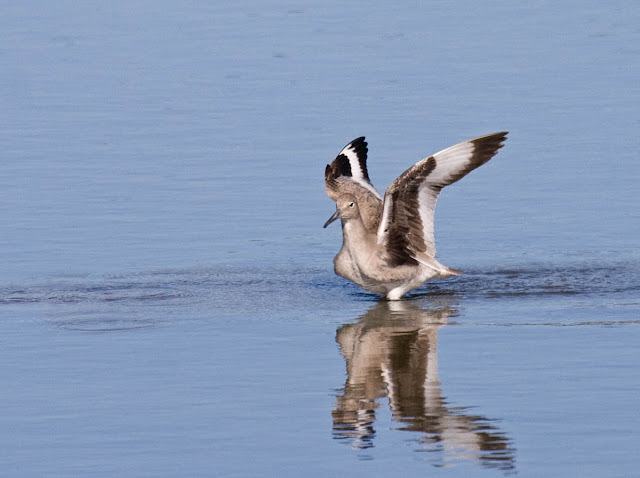 |
| High tide at San Elijo Lagoon, California. |
Here is my birding site guide to San Elijo Lagoon.
Many of the most obvious birds in the marsh have long legs for wading in the water and long bills for probing in the mud.
 |
| Marbled Godwit. San Elijo Lagoon, California. March 8, 2008. Greg Gillson. |
This large salmon-colored shorebird with the "too long" upturned bill breeds in the northern Great Plains and winters coastally. However, a number of non-breeding birds also summer on the California coast. Thus, Marbled Godwits can be found here throughout the year, though they are most common fall through spring. They prefer salt water, so they are found primarily either on the beach or in the lagoons. Similar San Diego birds: Long-billed Curlew, Whimbrel, Willet, perhaps the much smaller Long-billed Dowitcher and Short-billed Dowitcher.
 | |
| Ridgway's Rail. Imperial Beach, California. March 2, 2014. Greg Gillson. |
Formerly considered the western subspecies of Clapper Rail, this critically endangered bird is as rare as the saltwater marsh habitat it lives in. Fortunately, where the habitat has been restored these birds are making a strong comeback from the low point in the 1980's. Ridgway's Rails were only re-established in San Elijo Lagoon since 1982. They built to 8 pairs in 1997 but dropped again to only 1 pair in 2000-2001 (San Diego County Bird Atlas. Philip Unitt. 2004.). Rails are secretive marsh dwellers that are usually hard to actually see. But at lower tides birds may be observed crossing shallow channels or foraging for snails at the edge of the cordgrass. Sometimes, if one calls, all the birds erupt in calls throughout the marsh. A dozen birds or more may be heard or glimpsed now in San Elijo Lagoon, especially August through November. Similar San Diego birds: Virginia Rail, Sora, Least Bittern.
 |
| Black-necked Stilt. Imperial Beach, California. July 4, 2014. Greg Gillson. |
This black and white wader is graceful and elegant despite the almost impossibly long and shockingly bright coral pink legs. They nest at San Elijo Lagoon and numbers can reach over 100, but they don't usually flock together. They are only slightly less common in winter. They use injury-feigning and distraction displays to lead predators away from the ground-nests and chicks. Similar San Diego birds: American Avocet.
 |
| American Avocet. Oceanside, California. May 24, 2015. Greg Gillson. |
The stately avocets are often found with Black-necked Stilts year-round in sandy lagoons and shallow wetlands. This species has very long bluish legs and a thin upturned bill. In spring the head and neck sports a soft cinnamon-brown wash that disappears in winter. Semi-colonial; large numbers may flock together in any season. This rather large shorebird defends it nest and territory by screaming and strafing--flying straight at intruders (including people) who have ventured too close. Similar San Diego birds: Black-necked Stilt.
 |
| Cinnamon Teal. Chula Vista, California. December 31, 2015. Greg Gillson. |
This tiny little duck with the big bill is regular, but not overly numerous, in quiet, shallow, marshes choked with floating vegetation. It is found year-round in California, but harder to find in summer and early winter. An early migrant; by mid-January the spring migration is noticeable. Similar San Diego birds: The camouflage-patterned females of Cinnamon and Blue-winged Teal are very similar.
 |
| Willet. San Elijo Lagoon, California. August 3, 2014. Greg Gillson. |
 |
| Willet. San Elijo Lagoon, California. December 15, 2013. Greg Gillson. |
This larger shorebird is overall a rather non-descript gray throughout most of the year. In spring, it features a few browner spots and streaks. But when it flies it exposes its striking black-and-white wing pattern. They don't breed here, but a few non-breeding individuals may be found in summer, especially on the open beaches. But it is hard to tell a migrant from a summering bird, as spring migration continues through May and fall migration may begin by late June. Named for it's piercing and loud "Willet!" or "Pill-Will-Willet!" it is often first noticed by its call. Similar San Diego birds: None, really, but perhaps Whimbrel, Red Knot, Black-bellied Plover (bold wing stripe).
Birds to know in San Diego: introduction
Next: Birds to know in San Diego: Anza-Borrego Desert

No comments:
Post a Comment
I really want to hear from you! I've changed settings (again) in order to try to make commenting easier without opening it up to spammers. Please note, however, that comments to posts older than 14 days will be moderated. Thank you.